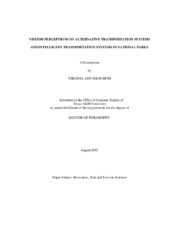| dc.description.abstract | This dissertation examines the potential use of intelligent transportation systems (ITS) and alternative transportation systems (ATS) in national parks. Visitors at two of the national park units in California, Golden Gate National Recreation Area (GOGA) and Sequoia and Kings Canyons National Parks (SEKI), were surveyed during May and July 2002 regarding their attitudes and intentions toward a variety of transportation and travel planning items (including ITS and ATS tools). There were three principal areas of inquiry: attitude toward transportation and travel planning tools, likelihood of using transportation and travel planning tools, and the difference between intentions for using tools before arriving at the study parks and while at the study parks.
The results revealed several key findings. First, there was substantial support for the relationship between attitudes and intentions. Furthermore, both experience with technology and attitude toward technology were predictive of intention to use technology in the study parks. Third, there was a significant difference between the attitudes and intentions of visitors to an urban park (GOGA) and visitors to a rural park (SEKI). In particular, GOGA respondents perceived alternative transportation (e.g. shuttle, public bus, park and bike) as more appropriate than did SEKI respondents. Fourth, while some support was found for a relationship between one of the ITS goals, safety, and attitude toward ITS tools in national parks, there was no support for the relationship between other ITS and ATS goals (e.g. reduction of congestion) and attitudes toward or intent to use these tools in national parks. Finally, there was a significant difference between the types of tools respondents would use before arriving at and while at the study parks. Technology such as the Internet was more likely to be used before arriving at the parks. Following from diffusion of innovations theory, changes in perception toward these tools, as well as possible changes in the likelihood that they will be used in national parks, may be monitored by future research. | en |


